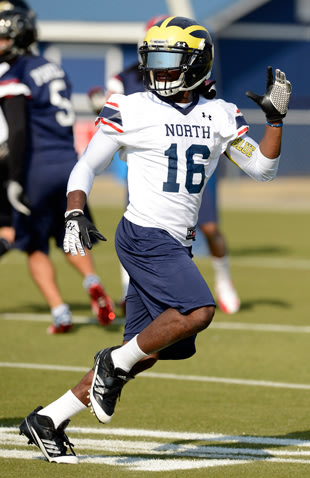
Now, after 47 career games at Michigan and 6,250 career passing yards and 49 career touchdown passes, Denard Robinson will have to be open to doing whatever it takes to get to the NFL. In this case, that means not playing quarterback anymore.
In what has been a sudden transition from Big Ten quarterback to hopeful NFL wide receiver, Robinson’s potential NFL suitors will be closely watching his March 14th Pro Day for his progression into a new position.
Robinson didn’t fully mesh with new head coach Brady Hoke’s offense in 2011, and throughout the 2012 season, he become more and more exposed in the pro-style passing attack. After a nerve injury on October 27th, Robinson was shifted to running back/receiver for part of his final games as a Michigan Wolverine. His time there (mostly at running back) allowed him to flash his elite speed and open field running ability, but didn’t show his value at his future NFL spot: receiver.
Arriving at the Senior Bowl in late January, Robinson only had 3 weeks to learn how to run a wide array of routes, get separation, elude press coverage, finish catches away from his body, and understand his role as a blocker. While he was heavily criticized for his lack of development as a receiver while in Mobile by many in the major media, I was able to put in perspective this quick turnaround and take Robinson for what he truly was: a work in progress.

At the NFL Combine, Robinson displayed his elite speed, quickness, and athleticism. A former sprinter for Michigan’s track and field team, Robinson was the team’s feature 60-meter dash runner in 2010. In Indianapolis, he ran a 4.42 (5th among WRs) and a 36.5 vertical jump (8th among WRs), showcasing his deep speed in the open field and his elite explosion initially.
Robinson’s Pro Day is the next step in his ability to show what he can be at the next level. He’ll likely stand on his Combine numbers, though he reportedly has run a 4.32 in his career, and may try and lower his already impressive Combine 40 time. But teams will be there to see his continued development as a route runner, his ability to extend away from his body to make catches, and his focus on the field to put his crash-course receiver work over the past few months into one, consolidated workout.
While his receiver work will be on display and critical to his draft grade, no NFL team will draft Robinson purely as a slot receiver in the top five rounds. Without any special teams experience as a gunner or on kickoff, Robinson can’t provide much help as a special teams’ tackler the way most mid-late rounders need to as rookies. Therefore, teams’ will need to feel he can add value as a running back and/or as a kick returner to be considered for a Top 125 selection.
He was college football’s best running quarterback for the past three years, and has the obvious open-field elusiveness and speed to produce big plays, but NFL teams will question if he can hold up as a 5-7 carry a game runner throughout a season without injury. Before the nerve damage however, he’d never missed a game since his sophomore year of high school.
As a returner, his quickness and explosion makes him a great fit, but only if he can gather the ball cleanly, something he hasn’t gotten down yet based off his Senior Bowl performance. He has the hand size (over 10 inches) to gather the ball, but it takes time to get this unique skill set developed.
He isn’t alone in this transition. We’ve had many success stories in the NFL of quarterbacks making the transition to receiver. Antwan Randle El, who’s Big Ten rushing record for a quarterback Robinson broke at Michigan, is one that’s a trendy comparison because of the position change and Big Ten ties.
Four quarterbacks in NCAA history have had two seasons of 2,000+ passing yards and 1,000+ rushing yards. They are Denard Robinson, the 49ers quarterback Colin Kaepernick, and two very comparable players to Robinson: Joe Webb of the Vikings and Brad Smith of the Bills. Despite being 2-3 inches taller, Brad Smith may be the best comparison for Robinson in projecting his future NFL role.
Denard Robinson has a lot on his plate leading up to the Draft. Can he develop the techniques of the receiver position? Can he develop the pass catching ability to be a reliable target in the NFL? Does he have early career value as a runner and/or kick returner?
Robinson has been trying to answer these questions to NFL teams since his final game at Michigan. The Senior Bowl and NFL Combine began to show his progression into changing positions. But March 14th at the University of Michigan may be his best, and final, chance to show what he can bring to an NFL franchise.
Add The Sports Daily to your Google News Feed!